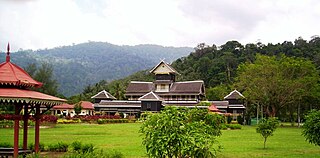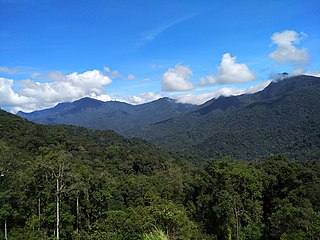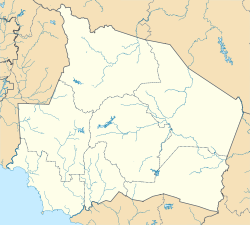
Negeri Sembilan, historically spelled as Negri Sembilan, is a state in Malaysia which lies on the western coast of Peninsular Malaysia. It borders Selangor on the north, Pahang in the east, and Malacca and Johor to the south.

Rendang is a Minangkabau dish. It is a rich meat-based dish that is slow-cooked, braised in coconut milk, and seasoned with herb and spice mixture over a period of several hours. As the liquids evaporate, the meat turns dark brown and tender, caramelizing and infusing it with rich flavours.

Seri Menanti is a town, a mukim and a state assembly constituency in Kuala Pilah District, central Negeri Sembilan, Malaysia, located 33 km east of the state capital city of Seremban and 14 km southwest of Kuala Pilah. It is the royal capital of the state of Negeri Sembilan and houses the seat of the Yang Di-Pertuan Besar of Negeri Sembilan or Yamtuan Besar, the ruler of the state of Negeri Sembilan. The royal palace is known as Istana Besar.

The Jelebu District is the second largest district in Negeri Sembilan, Malaysia after Jempol, with a population over 40,000. Jelebu borders on the Seremban District to its west and Kuala Pilah District to its south, Jempol District to its southeast, Bentong and Bera Districts, Pahang to its east and Hulu Langat District, Selangor to the north. Jelebu is a suburban district with blossoming semi-agricultural industry. Jelebu is also a parliamentary constituency of the Dewan Rakyat in the Malaysian Parliament. Kuala Klawang is the principal town of the district.

Sungai Muntoh is a semi-agricultural small town in Jelebu District, Negeri Sembilan, Malaysia with less than 3,500 in total population. The town is located about 30 miles southeast of Kuala Lumpur and is situated near the border between Negeri Sembilan and Selangor.

The Titiwangsa Mountains, also known as Banjaran Besar by locals, is the chain of mountains that forms the backbone of the Malay Peninsula. The northern section of the range is in southern Thailand, where it is known as Sankalakhiri Range.

Bahau is the principal town of Jempol District, Negeri Sembilan, Malaysia.

The Jempol District is the largest district in the Malaysian state of Negeri Sembilan. The district borders Jelebu District to the northwest, Kuala Pilah District to the west, Tampin District to the south, Bera District, Pahang to the northeast and Segamat District, Johor to the east. Bandar Seri Jempol and Bahau are the principal towns in Jempol.
Federal Route 86, also known as Jalan Jelebu or Jalan Seremban–Simpang Pertang, is a main federal roads in Negeri Sembilan, Malaysia. The roads connects Seremban town in the south to Simpang Pertang, Jelebu in the north. It was the earliest federal roads in Negeri Sembilan, built in 1911 by the Federated Malay States (FMS) government.

Kuala Klawang is a mukim and the district capital of Jelebu District, Negeri Sembilan, Malaysia.

Tan Sri Dato' Seri Utama Dr. Rais bin Yatim is a Malaysian politician and lawyer who served as the 18th President of the Dewan Negara from September 2020 to June 2023, 8th Menteri Besar of Negeri Sembilan from 1978 to 1982 and the Member of Parliament (MP) for Jelebu from November 1999 to May 2013.

The Seremban District is one of 7 districts in Negeri Sembilan, Malaysia. This is where the capital of Negeri Sembilan, Seremban is located.
The city of Seremban, Negeri Sembilan, Malaysia is linked by rail from KTMB's Seremban station to Kuala Lumpur, Singapore and the coastal town of Port Dickson, and has a commuter rail network. It lacks its own airport and is served by the nearby Kuala Lumpur International Airport. Local and longer-distance bus services use a bus station at Terminal 1 Bus Terminal and Shopping Centre, Negeri Sembilan's primary transportation hub. Major roads include Federal Route 1, Federal Route 51, Federal Route 86, Federal Route 366, North–South Expressway Southern Route (E2), Kajang-Seremban Highway (E21), Seremban-Port Dickson Highway (E29), and the Seremban Inner Ring Road (SIRR). The major streets in the city have been renamed since colonial days.
The flag and the coat of arms of Negeri Sembilan are state symbols of Negeri Sembilan, Malaysia. The symbols are predominantly depicted in red, black and yellow, traditional colours of the Minangkabau people who are the original settlers in the present-day state. Also recognised in the symbols are the political history of Negeri Sembilan, its ruler, and the state's past relationship with the British Empire.

Simpang Pertang is a small town in Jelebu District, Negeri Sembilan, Malaysia. It is a few kilometres away from the town of Pertang, which the intersection is named after.

Seremban is a city in the Seremban District and the capital of the state of Negeri Sembilan in Peninsular Malaysia. The city's administration is run by the Seremban City Council. Seremban gained its city status on 20 January 2020.

Kuala Pilah, or simply Pilah, is a town in Kuala Pilah District, Negeri Sembilan, Malaysia.

The Rembau District is a district that is located in the state of Negeri Sembilan, Malaysia. The district is a stronghold of the matrilineal system known as adat perpatih, a customary practice inherited from the Minangkabaus, of Sumatra. The district borders Seremban District to the north, Port Dickson District to the west, Tampin District to the east, Kuala Pilah District to the northeast and Alor Gajah District, Malacca to the southwest.

The Minangkabau Malaysians are citizens of the Malaysia whose ancestral roots are from Minangkabau of central Sumatra. This includes people born in the Malaysia who are of Minangkabau origin as well as Minangkabau who have migrated to Malaysia. Today, Minangkabau comprise about 989,000 people in Malaysia, and Malaysian law considers most of them to be Malays. They are majority in urban areas, which has traditionally had the highest education and a strong entrepreneurial spirit. The history of the Minangkabau migration to Malay peninsula has been recorded to have lasted a very long time. When the means of transportation were still using the ships by down the rivers and crossing the strait, many Minang people migrated to various regions such as Negeri Sembilan, Malacca, Penang, Kedah, Perak, and Pahang. Some scholars noted that the arrival of the Minangkabau to the Malay Peninsula occurred in the 12th century. This ethnic group moved in to peninsula at the height of the Sultanate of Malacca, and maintains the Adat Perpatih of matrilineal kinships system in Negeri Sembilan and north Malacca.




















